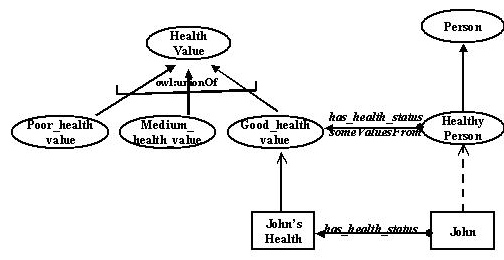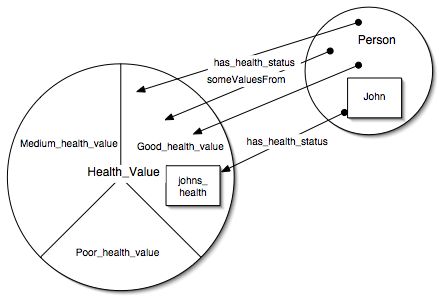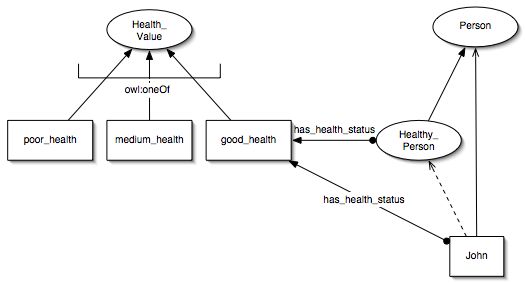There are many "qualities", "features", or "modifiers" used to describe
other concepts, e.g. size, severity, texture, rank, for which in any one
ontology there is a specified collection of 'values'. This document describes
two methods to represent such collections of values: as partitions of classes
or as enumerations of individuals. It does not disscuss the use of datatypes
to represent lists of values.
Status of this Document
This section describes the status of this document at the time of its
publication. Other documents may supersede this document. A list of current
W3C publications and the latest revision of this technical report can be
found in the W3C technical reports index
at http://www.w3.org/TR/.
This document is intended to be a part of a future W3C Working Group Note that will provide an
introduction and overview of all ontology design patterns produced by the Semantic Web Best Practices
and Deployment Working Group, part of the
W3C Semantic Web Activity.
This document is a W3C Working Draft and is expected to change. The SWBPD
WG does not expect this document to become a Recommendation. Rather, after
further development, review and refinement, it will be published and
maintained as a WG Note.
This document is a First Public Working Draft. We encourage public
comments. Please send comments to public-swbp-wg@w3.org [archive] and start the
subject line of the message with "comment:".
Open issues, todo items:
- Patterns for of use of datatypes to represent lists of values
Publication as a Working Draft does not imply endorsement by the W3C Membership.
This is a draft document and may be updated, replaced or obsoleted by
other documents at any time. It is inappropriate to cite this document as
other than work in progress.
General issue
There are many "qualities", "feature", or "modifiers" used to describe
other concepts, e.g. size, severity, texture, rank, for which in any one
ontology there are a specified collection of 'values'. In some circumstances
we also want to be able to represent modified values - e.g. "very
severe" and "mildly severe" or otherwise further subdivide values. In other
circumstances it is useful to be able to have two different collections of
values covering the same quality, for example to have different collections
of color values all partitioning the same "colour space" or to break up
"health status" into four rather than three levels.
There are at least three different ways to represent such specified
collections of values:
- As disjoint classes which exhaustively partition the parent class
representing the quality;
- As individuals whose enumeration makes up the parent class representing
the quality;
- As datatypes. Data types will more usually be used when there is a
literal, numeric or derived data types rather than when there is an
enumerated list of values. They will not be considered further in this
paper although a supplement may be issued.
Use case examples
We want to describe persons as having qualities such as having body type
that is slender, medium, or obese and as having health status that is good
health, medium health, or poor health. It should not be possible to have more
than one value for any of the qualities, e.g. it should be
inconsistent (unsatisfiable) to be both slender and obese or in good health
and poor health. We will use the quality "Health" in the examples. The others
follow analogously.
Diagraming Conventions
Ellipses represent classes. Squares represent instances. Closed
undecorated arrows (pointing upwards if possible) represent
rdfs:subclassOf; Open undecorated arrows indicate
rdf:type; arrows decorated with a blob on the origin indicate
restrictions if between classes or facts if between individuals. Restrictions
are existential unless otherwise marked. Dotted arrows indicate that they are
potentially inferrable by a reasoner from the other information. Upward
facing square union symbols if spanning a set of rdfs:subclassOf
links indicate owl:UnionOf; if spanning a set of
rdf:type links indicate owl:oneOf. All classes are
mutually disjoint and all individuals mutually different unless shown as
overlapping or otherwise annotated.
Representation patterns
Pattern 1: Values as subclasses partitioning a
quality
In this approach we consider the quality as a class representing a
continuous space that is partitioned by the values in the collection of
values. To say that "John is in good health" is to say that his health is
inside the Good_health_values partition of the
Health_value quality. Theoretically, there is an individual
health value, Johns_health, but all we know about it is that it
lies someplace in the Good_health_value partition. The cass
Healthy_Person is the class of all those persons who have a
health in the Good_health_value partition. [See note 1]

Figure 1: A class-instance diagram of the use of partitioning
classes for collections of values
Some may find an alternative diagrammatic format adapted from Venn
diagrams as shown in Figure 2 makes the intention clearer as it shows the
partioning more explicitly.

Figure 2: An adapted Venn diagram showing the use of partitioning
classes to represent lists of values.
Representation for two variants of Pattern 1
Representation variant 1: Using a fact about the individual
{{The collection of values}}
:Health_Value
a owl:Class ;
owl:equivalentClass
[ a owl:Class ;
{{The next line makes the partition exhaustive}}
owl:unionOf (:Poor_health_value :Medium_health_value :Good_health_value
] .
:Good_health_value
a owl:Class ;
rdfs:subClassOf :Health_Value ;
{{The disjoint axioms make the subclasses partitioning}}
owl:disjointWith :Poor_health_value , :Medium_health_value .
:Medium_health_value
a owl:Class ;
rdfs:subClassOf :Health_Value ;
owl:disjointWith :Poor_health_value , :Good_health_value
:Poor_health_value
a owl:Class ;
rdfs:subClassOf :Health_Value ;
owl:disjointWith :Good_health_value , :Medium_health_value .
{{The functional property}
:has_health_status
{{The property must be functional}}
a owl:ObjectProperty , owl:FunctionalProperty ;
rdfs:domain :Person ;
rdfs:range :Health_Value
{{The class Person, its subclass
Healthy_person, and an individual person, John}}
:Person
a owl:Class.:John
a :Person ;
:has_health_status :johns_health .
:johns_health
a :Good_health_value .
:Healthy_person
a owl:Class ;
owl:equivalentClass
[ a owl:Class ;
owl:intersectionOf (:Person [ a owl:Restriction ;
owl:onProperty :has_health_status ;
owl:someValuesFrom :Good_health_value
])
] .
Representation using variant 2: Placing an existential restriction on the
individual
{{The same as variant 1 except that for the
individual Jim, is represented as}}
:Jim
a :Person ;
[a owl:Restriction;
owl:onProperty :has_health_status ;
owl:someValuesFrom :Good_health_value].
Considerations using Pattern 1:
- The result is in OWL-DL and classifies correctly using either FaCT or
Racer - and almost certainly any other reasoner that handles any
reasonable subset of OWL-DL.The semantics faithfully represent the
partitioning of a continuous quality space into a collection of discrete
value.
- The values can be further subpartitioned, e.g.
Good_health_value might be split into
Moderately_good_health_value and
Robust_good_health_value, simply by subdividing the
Good_health_value partition.
- There can be several alternative partitionings of the same quality
space.
- If variant 2 is to be used as part of a database schema or similar,
then a convention for creating anonymous instances in the database is
required. (Logicians call such anonymous instances "skolem constants".)
In practice, this can usually be ignored. A common convention is to use
the class name or a string derived from it, e.g.
"
good_health" as the symbol in the database. The fact that,
strictly speaking, the semantics require the symbol to be interpreted in
each case as a different anonymous instance of the class
Good_health_value will, in this case, be irrelevant to most
applications and invisible to most users.
- The use of classes for values seems unintuitive to many people coming
from the database and frame communities in which value sets are usually
enumerated lists of symbols.
Code for this example
[N3] [RDF/XML abbrev] [Abstract
syntax] [Protege-OWL]
Pattern 2: Values as individuals whose enumeration is equivalent to the
quality
In this approach, the class Health_Value is considered as the
enumeration of the individuals good_health,
medium_health, and poor_health. Values are sets of
individuals. To say that "John is is in good health", is to say that "John
has the value good_health for health" This assumes that a value is just an
unique symbol, and a value set is just a a set of such symbols. Normally, the
values will all need to be asserted to be different from each other. ( In
OWL, any two individuals might represent the same thing unless there is an
axiom to say, explicitly, that they are different. In other words, OWL does
not make the "Unique Name Assumption".) If we did not include the
differentFrom axiom in the example, then it would be possible to
have a person who was, for example, both in good health and poor health
simultaneously.
The approach is shown diagrammatically in Figure 3.

Figure 3: A class-instance diagram of the use of enumerated
instances to represent lists of values
Representation for Pattern 2
{{The value set}}
:Health_value
a owl:Class ;
owl:equivalentClass
[ a owl:Class ;
{{Define as one of three individuals}}
owl:oneOf (:medium_health :good_health :poor_health)
] .
:good_health
a :Health_value ;
{{The next line make values different. Otherwise might be inferred the same}}
owl:differentFrom :poor_health , :medium_health .
:medium_health
a :Health_value ;
owl:differentFrom :poor_health , :good_health .
:poor_health
a :Health_value ;
owl:differentFrom :good_health , :medium_health .
:has_health_status
a owl:ObjectProperty , owl:FunctionalProperty ;
rdfs:range :Health_value .
{{John - a health person}}
:John
a :Person ;
:has_health_status :good_health .
{{The class of Healthy Persons}}
:Healthy_person
a owl:Class ;
owl:equivalentClass
[ a owl:Class ;
owl:intersectionOf (:Person [ a owl:Restriction ;
owl:hasValue :good_health ;
owl:onProperty :has_health_status
])
] .
Considerations using Pattern 2:
- The representation is in OWL-DL, and DL reasoners should eventually be
expected to make correct inferences with individuals used in this way.
However, neither FaCT nor Racer (the two most widespread open source
reasoners in use today) perform all the expected inferences reliably.
- There is no possibility of further subpartitioning of values. This is
because OWL supports only equality or difference between individuals. It
does not allow individuals to have partial overlaps. It is not possible,
as it is for classes, to say that one individual is equivalent to the the
union (disjunction) of two other individuals.
- There is no way to represent alternative partitionings of the same
quality space. Because individuals cannot overlap, if
Health_Value is defined as equivalent to enumeration of one
list of distinct values, it cannot also be equivalent to a different list
of distinct values. To do so would cause the reasoner to indicate a
contradiction. (i.e that Health_Value was
"unsatisfiable".)
- There is a straight forward match to the usage in databases and many
frame systems without any assumptions or conventions about anonymous
individuals.
- Many people find this the more intuitive approach.
OWL code for this example
[N3] [RDF/XML abbrev] [Abstract syntax] [Protege/OWL}
Notes
[Note1]. In this document we have carefully
distinguished between the class partitioning the value type as used in
Pattern_1, e.g. Good_health_value, and an individual value in a
value type as used in Pattern_2, e.g. good_health. In any given
ontology we would normally advise against mixing the two patterns. If an
ontology uses Pattern_1 consistently, then we might drop the
_value suffix. However, we strongly suggest maintaining
consistent naming and case conventions throughout any one ontology.
Acknowledgements
The code in these examples should be viewable with any owl tools. The
following is for information only and with thanks to those involved in
developing the tools. There is no endorsement intended or implied for the
specific tools. These examples have been produced using the Protege OWl
plugin and CO-ODE additional wizards and OwlViz available from http://protege.stanford.edu and
following plugins/backends/owl. Some files may require the CO-ODE plugins
linked to that page or at http://www.co-ode.org. Classification
involving individuals cannot all be shown in this form and has been tested
using OilEd available from http://oiled.man.ac.uk. In all cases the
Racer classifier has been used, available from http://www.sts.tu-harburg.de/~r.f.moeller/racer/.
References
Rector, A., Modularisation of Domain Ontologies Implemented in Description
Logics and related formalisms including OWL. in Knowledge Capture 2003,
(Sanibel Island, FL, 2003), ACM, 121-128. pdf here


